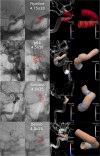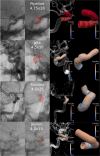Cerebral Aneurysm Occlusion at 12-Month Follow-Up After Flow-Diverter Treatment: Statistical Modeling for V&V With Real-World Data
- PMID: 35047944
- PMCID: PMC8757794
- DOI: 10.3389/fmedt.2021.705003
Cerebral Aneurysm Occlusion at 12-Month Follow-Up After Flow-Diverter Treatment: Statistical Modeling for V&V With Real-World Data
Abstract
Background: Flow-Diverter (FD) porosity has been pointed as a critical factor in the occlusion of cerebral aneurysms after treatment. Objective: Verification and Validation of computational models in terms of predictive capacity, relating FD porosity and occlusion after cerebral aneurysms treatment. Methods: Sixty-four aneurysms, with pre-treatment and follow-up images, were considered. Patient demographics and aneurysm morphological information were collected. The computational simulation provided by ANKYRAS provided FD porosity, expansion, and mesh angle. FD occlusion was assessed and recorded from follow-up images. Multiple regression Logit and analysis of covariance (ANCOVA) models were used to model the data with both categorical and continuous models. Results: Occlusion of the aneurysm after 12 months was affected by aneurysm morphology but not by FD mesh morphology. A Time-To-Occlusion (TTO) of 6.92 months on average was observed with an SE of 0.24 months in the aneurysm population surveyed. TTO was estimated with statistical significance from the resulting model for the data examined and was capable of explaining 92% of the data variation. Conclusions: Porosity was found to have the most correction power when assessing TTO, proving its importance in the process of aneurysm occlusion. Still, further Verification and Validation (V&V) of treatment simulation in more extensive, multi-center, and randomized databases is required.
Keywords: cerebral aneurysms; device porosity; device sizing; flow diverter; time-to-occlusion.
Copyright © 2021 Narata, Obradó, Moyano, Macho, Blasco, Rueda, Roman, Remollo, Marinelli, Cepeda, Fernández and Larrabide.
Conflict of interest statement
IL and HF hold ownership of stock in Galgo Medical S. L. LO and RK were employed by Galgo Medical S. L. at the time of preparation of the manuscript. The remaining authors declare that the research was conducted in the absence of any commercial or financial relationships that could be construed as a potential conflict of interest.
Figures




References
LinkOut - more resources
Full Text Sources

